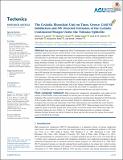Files in this item
The cycladic blueschist unit on Tinos, Greece : cold NE subduction and SW-directed extrusion of the cycladic continental margin under the Tsiknias Ophiolite
Item metadata
| dc.contributor.author | Lamont, Thomas N. | |
| dc.contributor.author | Searle, Michael P. | |
| dc.contributor.author | Gopon, Phillip | |
| dc.contributor.author | Roberts, Nick M. W. | |
| dc.contributor.author | Wade, Jon | |
| dc.contributor.author | Palin, Richard M. | |
| dc.contributor.author | Waters, David J. | |
| dc.date.accessioned | 2020-09-28T14:30:05Z | |
| dc.date.available | 2020-09-28T14:30:05Z | |
| dc.date.issued | 2020-09-22 | |
| dc.identifier | 269225806 | |
| dc.identifier | 8def7636-0a74-4bb5-a1f1-a39bfc7f158e | |
| dc.identifier | 85091196440 | |
| dc.identifier | 000576412900005 | |
| dc.identifier.citation | Lamont , T N , Searle , M P , Gopon , P , Roberts , N M W , Wade , J , Palin , R M & Waters , D J 2020 , ' The cycladic blueschist unit on Tinos, Greece : cold NE subduction and SW-directed extrusion of the cycladic continental margin under the Tsiknias Ophiolite ' , Tectonics , vol. 39 , no. 9 , e2019TC005890 . https://doi.org/10.1029/2019TC005890 | en |
| dc.identifier.issn | 0278-7407 | |
| dc.identifier.other | RIS: urn:C0A9443F67D65711F079C111F4941D44 | |
| dc.identifier.uri | https://hdl.handle.net/10023/20697 | |
| dc.description | This work forms part of T. N. Lamont’s doctoral project which is funded by the Natural Environment Research Council (Grant No. NE/L0021612/1) and the University of Oxford for covering publication fees. | en |
| dc.description.abstract | High pressure–low temperature (HP–LT ) metamorphic rocks structurally beneath the Tsiknias Ophiolite, make up the interior of Tinos Island, Greece, but their relationship with the overlying ophiolite is poorly understood. Here, new field observations are integrated with petrological modelling of eclogite and blueschists to provide new insight into their tectono‐thermal evolution. Pseudomorphed lawsonite‐, garnet‐, and glaucophane‐bearing schists exposed at the highest structural levels of Tinos (Kionnia and Pyrgos Subunits) reached ca. 22–26 kbar and 490–520 °C under water‐saturated conditions, whereas pseudomorphed lawsonite‐ and aegirine‐omphacite bearing eclogite reached ca. 20–23 kbar and 530–570 °C. These rocks are separated from rocks at deeper structural levels (Sostis Subunit) by a top‐to‐SW thrust. The Sostis Subunit records P–T conditions of ca. 18.5 kbar and 480–510 °C and is overprinted by pervasive top‐to‐NE shearing that developed during exhumation from (M1) blueschist to (M2) greenschist‐facies conditions of ca. 7.3 ± 0.7 kbar and 536 ± 16 °C. These P–T–D relationships suggest that the Cycladic Blueschist Unit, represents a discrete series of tectono‐metamorphic subunits that each experienced different tectonic and thermal histories. These subunits were buried to variable depths and sequentially extruded towards the SW from a NE‐dipping subduction zone. The difference in age and P–T conditions between the HP–LT rocks and the overlying metamorphic sole of the Tsiknias Ophiolite, suggest this NE‐dipping subduction zone, was active between ca. 74 and 46 Ma, and cooled at a minimum rate of ~1.2–1.5 °C/km/Myr prior to continent‐continent collision between Eurasia and Adria/Cyclades. | |
| dc.format.extent | 45 | |
| dc.format.extent | 22755358 | |
| dc.language.iso | eng | |
| dc.relation.ispartof | Tectonics | en |
| dc.subject | Lawsonite | en |
| dc.subject | Petrological modelling | en |
| dc.subject | Cycladic Blueschist Unit | en |
| dc.subject | Extrusion tectonics | en |
| dc.subject | Tinos | en |
| dc.subject | GE Environmental Sciences | en |
| dc.subject | DAS | en |
| dc.subject.lcc | GE | en |
| dc.title | The cycladic blueschist unit on Tinos, Greece : cold NE subduction and SW-directed extrusion of the cycladic continental margin under the Tsiknias Ophiolite | en |
| dc.type | Journal article | en |
| dc.contributor.institution | University of St Andrews. School of Earth & Environmental Sciences | en |
| dc.identifier.doi | https://doi.org/10.1029/2019TC005890 | |
| dc.description.status | Peer reviewed | en |
| dc.date.embargoedUntil | 2020-09-22 |
This item appears in the following Collection(s)
Items in the St Andrews Research Repository are protected by copyright, with all rights reserved, unless otherwise indicated.

